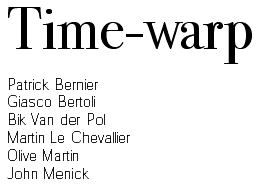 |
Sept 10 - Oct.
31 2003 |
For
the first time since the Grand Opening, the galerie proposes a group exhibition
with young artists of the gallery, Patrick Bernier (F) et Olive Martin
(F), and guests, Giasco Bertoli (Swiss), Bik Van der Pol (Netherlands), Martin Le Chevallier (F), and John Menick (USA). | |
| Press Release in PDF | |
| Patrick Bernier | ||||
| QUELQUES
K DE MEMOIRE VIVE, | ||||
| Giasco Bertoli | ||||
 | Swimming
Pool and Tree 1999 color photograph, framed 118 x 95 cm ed. 1/3 | |||
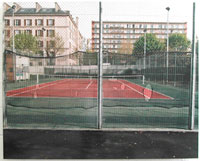 | Paris
XXe 2000 color photograph on aluminium 120 x 150 cm ed. 1/3 | |||
| Bik Van der Pol | ||||
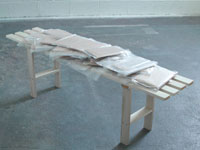 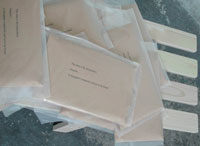 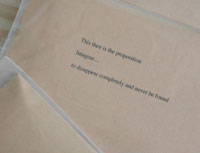
| How
to disappear 1998 - 2003 | |||
The
disappearance piece was initially made for a show in Rotterdam in 1998. This show
questioned the position and role and the possible ‘death’ of the spectator.
On a platform (366 x 366 cm) a little bench was placed, an edition of 100 books
were layed out, wrapped up in envelopes. The book, entitled “How To Disappear
Completely and Never Be Found” by D. Richmond, is a self-help instruction
book about planning a disappearance, arranging a new identity, pseudocide and
more. Eighty four packages were taken by the public, however the public was not
invited or encouraged to do so: this was up to themselves. In order to take a
bag one had to step onto the platform. In 2000 the piece was re-installed in Trailer,
a group show at Greene Naftali Gallery, New York (USA). Again 100 bags with content
were placed on a bench, this time with no platform. After the end of the exhibition,
4 bags were left. Bik Van der Pol, 2001. L'œuvre How to disappear a été présentée initialement dans une exposition à Rotterdam en 1998, dont le thème était la position, le rôle et la possible 'mort' du spectateur. Sur une platforme en bois, un banc supporte 100 exemplaires enveloppés du livre de Doug Richmond “How To Disappear Completely and Never Be Found”. Cet ouvrage propose, sous la forme d'un manuel d'instruction, les différentes manière de plannifier une disparition, une nouvelle identité, un pseudocide, etc. Quatre vingt quatre copies furent emportées par le public, bien qu'il n'y soit pas spécialement invité. En 2000, l'œuvre fut réactivée pour un group show à la Greene Naftali Gallery, NY. A la fin de l'exposition, seulement quatre paquets restèrent. | ||||
| Martin Le Chevallier | ||||
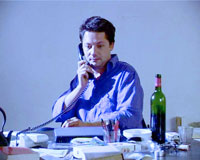 | Oblomov 2001 Color video, silent, interactive, projection. Starring Olivier Bardin. Filming : Nicolas Chesnais. Made with the support of DICREAM. | |||
A
character alone and idle. Thinking or asleep, he stays indefinitely motionless
until a member of the audience decides to. If the audience acts, that is, if a
somebody "clicks", the character executes an action. He gets up, he
phones, he smokes a cigarette, etc. As soon as this simple action is finished,
he returns back to his contemplative mood, threatened by a new "click".
This project has been carried out through a simple video procedure. This method
consists in keeping idefinitely a second of a video sequence until the audience
intervenes. Thus foliage could stay in motion, or a fountain gushing forth, or
a man sleeping, etc. The image is never fixed. Life seems to carry on. The intervention
(the "clic") of the spectator can be compared to the intervention of
a videogame player guiding his character. But an essential difference is that
the audience does not intervene in a reconstituted reality but in a reality seized
photographically. The audience has in this way the impression that he acts on
this reality, waking up the asleep, shaking the idle. This film is freely inspired by the character created by Ivan Gontcharov in his homonymous novel. The audience faces an individual whose natural inclination is to do nothing. The choice is in respecting his tranquility or not. The audience ignores the action that the click will provoke, in this sense the impulsion is not "Do this! Do that!" but rather "Do something!". Interactivity is thus reduced to its more simple expression. Un personnage seul et inactif. Pensif ou endormi, il reste indéfiniment immobile tant que le spectateur ne fait rien. Si le spectateur intervient ("clique"), le personnage effectue une action. Il se lève, téléphone, fume une cigarette, etc. A peine sa tâche achevée, le personnage retrouve son état contemplatif, jusqu'à ce que le spectateur intervienne de nouveau. Ce projet est réalisé au moyen d'un procédé qui consiste à faire persister un instant d'une séquence vidéo aussi longtemps que le spectateur n'intervient pas. Un feuillage reste ainsi indéfiniment animé, une fontaine jaillissante, un dormeur assoupi, etc. L'image ne se fige jamais. La vie semble se poursuivre. L'intervention (le "clic") du spectateur est comparable à celle du joueur de jeu vidéo qui guide son personnage. La différence - essentielle - tient à ce qu'il n'agit pas sur une réalité reconstituée en deux ou trois dimension, mais sur une réalité saisie photographiquement. Il a ainsi la sensation d'intervenir sur cette réalité, de réveiller le dormeur, de bousculer l'inactif. Ce film s'inspire librement du personnage créé par Ivan Gontcharov. Le spectateur est confronté à un individu dont l'inclination naturelle est de ne rien faire. Son seul choix est de respecter ou non la tranquillité du personnage. Ignorant quelle sera l'action qu'il déclenche, son impulsion n'est pas le "fait ci! fait ça!" du jeu vidéo, mais un simple "Fait quelque chose!". L'interactivité est alors réduite à sa plus simple expression. | ||||
| Olive Martin | ||||
 | Loop A film by Olive Martin Realized in 16 mm, Chicago, 1999. Duration : 6,30 min. DVD, b&w, silent | |||
With
(in order of appearance) : Jeff Semmerling, Moisès Manas, Noël Skryzpczac,
Marie Daubert, Dubi Kaufmann, Chang-Qui Su, Sinead Show, Wyan Love, Seul-Gi Lee,
Ken Burak, Patrick Bernier, Liz Wheeler, Anneliesse Popescu. Loop was realized in spring '99, in the town center of Chicago, with the help of fifteen extras acting by taking over from one another, walking around a block. Thanks to the editing, the three protagonists of the movie moult and exhaust the actors. Loop a été tourné au printemps 99, dans le centre de Chicago, avec le concours d'une quinzaine de figurants se relayant autour d'un "block", unité architecturale de la ville. Les trois protagonistes du scénario profitent du montage pour muer et épuiser les interprètes. | ||||
 | Jean
Martin, Parvis de Beaubourg, Paris, Hiver 1978 2002 Ink jet print on PVC, framed 140 x 110 cm Photograph by Alain Feffer, Paris, 1978. | |||
"This
photograph, recovered in the family's archives, and printed as a poster, transforms
my father (who 's patronymic is very banal in french) as an Antoine Doisnel [young
hero of The 400 Blows by François Truffaut, 1959] " " Sachant que le besoin de fréquenter le musée ou l‚église a pour condition la fréquentation du musée ou de l'église et que la fréquentation du musée ou de l‚église suppose le besoin de fréquenter, on voit que, pour briser le cercle de la première entrée à l‚église ou au musée, il faut que soit donnée une prédisposition à la fréquentation qui, sauf à croire au miracle de la prédestination, ne peut être autre que la disposition de la famille à faire fréquenter en fréquentant, le temps que cette fréquentation produise une disposition durable à fréquenter. " P. Bourdieu, " La reproduction ", Paris, Les Editions de Minuit, 1970, p. 54 | ||||
| John Menick | ||||
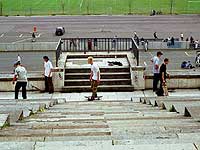  
| The
Disappearance | |||
This
video is a cinematic research taking the form of a location scouting for a film
to be shot in Nuremberg. Location scouts are employed by film productions to find
sites for the shooting of a film. They take photographs of a location and write
commentaries on the suitability of that site for the given scene. The movie itself is a fictional production that will not be filmed. It is a narrative about a detective investigating a disappearance. A video presentation of locations in the city will be shown with an audio soundtrack describing the possible usage of the sites, as well as how they evoke the city's history. Cette vidéo est une recherche cinematographique qui prend la forme d'un repérage pour un film qui devrait être réalisé à Nuremberg. Les repérages sont employés par les producteurs cinématographiques pour trouver des emplacements pour réaliser un film. Ils prennent des photographies d'un tel site et retiennent sa convenance pour une scène déterminée. Le film est une production fictive qui ne sera pas filmée. Il s'agit de la narration d'un détective qui investigue une disparition. La vidéo présente une série de localisations accompagnée de commentaires qui décrivent le possible usage de ces emplacements et comment ils évoquent l'histoire de la ville. This video is available in English, French German and Spanish. | ||||
|
Galerie
Maisonneuve T/F +33 1 43 66 23 99
contact@galerie-maisonneuve.com |